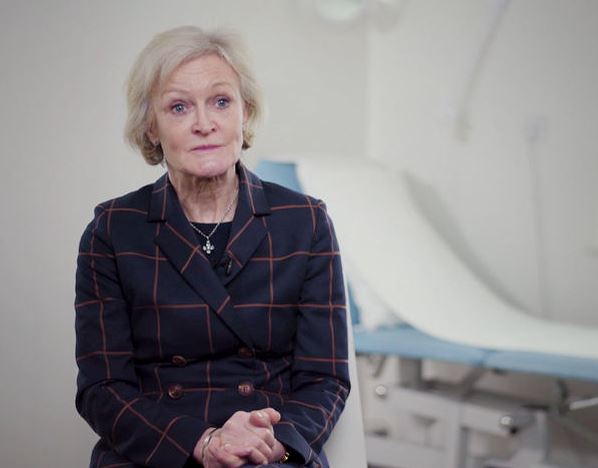Medically Reviewed January 2024,
by Mr. Bryan Mayou (GMC: 1414396) - founder of the Cadogan Clinic and one of the world's leading plastic surgeons
What are Skin Cancers and Melanomas?
Skin cancer occurs when the genetic material inside the cells changes, causing an alteration in how cells behave. They can increase in size and number, leading to the development of a tumour.
The most dangerous form of skin cancer is melanoma, which can develop from existing moles or develop as new standalone marks on the skin. The combination of regular self-checks and six monthly mole mapping appointments at the Cadogan Clinic will help to catch melanomas in the early stages. Moles which are turning into melanomas may become larger, more raised, change shape or colour and may become itchy, sore or bleed. However not all melanomas present in the same way. Any mole changes should be taken seriously and medical advice should be sought from a skin cancer specialist as soon as possible.
Other types of skin cancers are basal cell cancers and squamous cell cancer.
Skin cancer generally develops on parts of the body which are exposed to the sun, such as the arms and face. But skin cancers and melanomas can also be found on parts of the body which are shielded from the sun’s rays, so it is important not to be complacent when it comes to moles on areas which are not normally exposed to UV light from the sun or sunbeds.
Fortunately, most skin cancers can be cured if they are detected early. If any worrying moles do turn out to be cancerous, they must be removed immediately via surgical excision or Mohs surgery.
Although anyone is at risk of developing skin cancer, there are a number of risk factors which may make a person more susceptible. These include having fair skin, a history of severe sunburn, working outside on a frequent basis and having a weakened immune system.
Although skin cancer is more common in people with fair skin, people of colour can still get skin cancer and should have regular mole checks.
Get in touch
What symptoms should I look for?
The symptoms of skin cancer can vary, depending on what type of cancer you have. Cancerous moles may not always present in the same way.
But there are several key things that you should look out for when checking your moles. These are conveniently broken down for the ABCDE checklist and includes the following:
- A is for asymmetry: Healthy moles look the same on both halves. If one side of the mole looks different to the other, this could be a skin cancer symptom.
- B is for border: A normal mole has a well-defined border. A worrying mole will have a ragged or notched border and the pigment may be bleeding into the surrounding skin.
- C is for colour: Healthy moles are uniform in colour. A melanoma is usually a mix of two or mole colours, such as black, tan, brown, red, pink, grey, white or even blue. However amelanotic melanoma may have no colour at all.
- D is for diameter: Melanomas typically increase in size. Most measure more than 6mm in diameter.
- E is for evolving: In short, if a mole has changed size, shape, colour or in any other way, it is a cause for concern.
But when you carry out skin cancer checks, a worrying mole may have one, some or none of the above. As well as the ABCDE checklist, you should also apply The Ugly Duckling Test - if something doesn’t look right, it needs to be checked out.
Other symptoms which you should look out for are oozing, bleeding, pain, itchiness, redness, swelling or sores which do not heal. The texture of a melanoma varies and they may present as lumpy, crusty or scaly.
Here at the Cadogan Clinic, we offer a mole mapping service, where a skin cancer specialist will check all your moles and if there are any moles which may pose a problem in the future, then these can be monitored. We recommended mole mapping every six months. As well as mole mapping, you should continue to check your moles yourself every month using the ABCDE checklist as a guide. If you notice anything of concern, you should seek medical advice straight away.

What are the different types of Skin Cancer?
Skin cancers are divided into two categories - non-melanoma skin cancer and melanoma.
The term 'non-melanoma' refers to basal cell cancers and squamous cell cancer. In the UK alone there are more than 100,000 new cases of non-melanoma skin cancer diagnosed each year. These are more common than melanomas, and are typically slightly less serious as they are less likely to spread to other parts of the body. They are not connected to moles, and are found commonly in two forms:
Basal Cell Cancer (BCC)
A BCC starts in the basal layer of the skin, the lowest layer of the epidermis, and is the most common type of skin cancer, accounting for 75% of all cases.
BCC usually appears as a small, pinkish or pearly white lump with tiny blood vessels on the surface. It also can also present as a red, dry/scaly patch of skin or there may be brown or black spots or pigmentation within the affected patch of skin.
The lump grows slowly and may begin to crust over and bleed. Basal Cell Cancer can also develop into a non-healing ulcer.
Squamous Cell Cancer (SCC)
SCC starts in the upper layers of the epidermis and is the second most common form, accounting for 25% of all cases of skin cancer.
SCC usually presents as a firm, pink lump with a crusted surface. There may be scaling or rough patches on the lump and some people may notice a spiky horn protruding from the top.
The SCC will be tender to the touch and bleeds easily. Just like BCC, squamous cell cancer may also develop into an ulcer.
SCC is more dangerous than BCC as it is more likely to spread to other parts of the body.
Melanoma is the least common form of skin cancer, with less than 15,000 cases diagnosed each year, but it is the deadliest. It can develop anywhere on the body but most commonly on areas of the body that have been overexposed to the sun.
Melanoma can develop from existing moles, but around 70% develop as new marks or lesions on the skin. There are several types of melanomas, including:
Superficial Spreading Melanomas
These are the most common type of melanoma, accounting for around 80 percent of all reported cases in the UK. Superficial spreading moles are more common in people with pale skin and freckles. People with darker skin are much less likely to develop this particular type of melanoma.
These moles tend to spread radially at first, meaning they are confined to the skin. But if these start to grow deeper, they can spread to other parts of the body.
Superficial spreading moles often have an irregular edge. If you have any mole with an irregular border, you should get it examined by a doctor straight away.
Lentigo Maligna Melanomas
This type of melanoma accounts for around 10% of all reported cases of melanoma in the UK. Lentigo maligna melanomas usually affect older people, particularly those who have spent a lot of time outdoors in the sun.
This type of melanoma is flat and looks like a freckle, but it is usually larger, darker and more prominent. Lentigo maligna melanomas develop slowly, over the course of several years, and appear on parts of the body which are exposed to the sun, such as the face. They can get larger and may change shape. If they start to grow downwards and become nodular or change shape or pigmentation, it is likely that melanoma has developed.
Acral Lentiginous Melanoma
These are a rare type of melanoma, accounting for only 5% of all reported cases. They usually appear on the palms of hands, the soles of feet or around a finger/toenail. They are the most common type of melanoma in people with dark skin, although they can appear on anyone, regardless of skin colour.
Amelanotic Melanoma
These are another rare type of melanoma, accounting for only 5% of all reported cases in the UK. They may have little or no colour or may be pink or greyish spots on the skin.
The cost of a Skin Cancer Service
Dermatologist-Led: our skin cancer service is dermatologist-led, meaning that every skin cancer patient is seen and treated by a trained dermatologist
Plastic surgeon- supported: we have a team of fifteen plastic surgeons who provide support to our dermatology team for more complex cancer cases or reconstructions, or in cases where the patient is particularly sensitive to scarring
Rapid, Same-day Removal: we able to offer rapid, same day removal of skin cancers due to our three fully staffed on-site theatres
Mohs Surgery: we are one of the few facilities in London to offer the latest, cutting-edge Mohs surgery , the optimal approach for removing skin cancers as determined by NICE (National Institute for Health & Care Excellence)
What are the options?
Depending on the size and nature of the lesion, we offer the following skin cancer removal methods here at the Cadogan Clinic.
After carrying out an assessment, your dermatologist will recommend removing the skin cancer if it is dangerous, or if it is considered potentially dangerous and you would rather eliminate the risk than continue to monitor the growth. A non-cancerous growth may be removed if it is protruding and is being irritated by clothing, for example by catching on belts or bra straps. You may also wish to have a non-cancerous mole removed if it bothers you for cosmetic reasons.
Cryotherapy
Also known as freezing, this treatment is used to treat Basal cell carcinomas. Liquid nitrogen is applied to the skin lesion for five to ten seconds, freezing the skin cells until they die, causing the lesion to scab over and eventually fall off. More than one treatment may be required, depending on the patient and their skin type. Cryotherapy treatment is best for the treatment of superficial benign lesions.
Mole shaving
This type of mole removal sees a thin, razor-like tool used to carefully remove the affected mole. This type of surgery is quick, effective and no stitches are required after mole shaving. It is a minimally invasive form of surgery and can be performed under a local anesthetic.
Surgical excision
This type of skin cancer removal goes deeper than mole shaving. First the area around the mole is cleaned and a surgical drape placed around the area to ensure a sterile working area. The dermatologist then cuts out the whole mole and down into the subcutaneous fat layer below. The dermatologist will then apply sutures. Just like mole shaving, this form of melanoma removal is usually carried out under a local anesthetic. The process takes no longer than half an hour and you can leave the clinic on the same day.
Mohs surgery
Mohs surgery is the most effective technique for removing the most common types of skin cancer. The surgery works by removing successive thin layers of cancerous skin and examining each layer under a microscope as the surgery progresses until only cancer-free skin tissue is left.
Once again, this procedure is carried out under a local anaesthetic. The surgeon will use a marker pen to draw around the visible area of skin cancer before removing it with a very fine margin of healthy skin around the underneath it. The excised tissue is then examined under a microscope to see if any cancer cells remain. It can take up to an hour for the technician to assess this and you will be asked to wait with a dressing over the wound site.
If cancerous tissue is found in the skin examined under the microscope, a further layer will be removed from the corresponding area on the wound. This process will be repeated until all the cancer cells have been removed. In 80% of cases, a patient will only need to have one layer of skin removed.
This comprehensive skin cancer removal is performed as an outpatient procedure, so you will be allowed to go home the same day.
Mohs surgery is an excellent treatment for more aggressive forms of skin cancers, skin cancers that have a risk of recurrence and skin cancers which are found in more sensitive areas of the body, for example the nose, ears, eyes, hands, feet and genitals.
You should never try and remove a mole yourself. As well as the risks of infection and scarring, if the mole is cancerous, you run the risk of cancer cells being left behind. Book an appointment for skin cancer removal at our Chelsea clinic.
Cadogan Clinic. A strong tradition of innovation

Founded in 2004 by world renown dermatologist Dr Susan Mayou, we now work with over 100 leading consultants and successfully treat over 20,000 patients each year. We have been winning industry awards since inception.
Get in touch
Skin Cancers and Melanomas Surgeons
We have invited a selection of the country's very best consultants to join us at the Cadogan Clinic so that you can be sure that whatever the nature of your treatment, you will be seeing one of the top practitioners in the country.
How are Skin Cancers and Melanomas Diagnosed?
If you suspect you have any form of skin cancer, you must speak to your dermatologist or GP immediately and seek a specialist assessment.
If you discover a concerning mole, or one is picked up at your mole mapping appointment, one of the Cadogan Clinic’s skin cancer specialists will examine the growth using a dermoscope. A dermoscope is a specialist microscope which is used to examine skin lesions more closely.
Your dermatologist will ask you questions about your medical history and family history in order to find out whether there have been any cases of melanoma in your close family. You will also be asked about your use of sunbeds, sunbathing and whether you have had any bouts of severe sunburn. Your dermatologist will also ask about potential exposure to certain substances which are known to cause skin cancer, such as creosote.
If skin cancer is suspected, but not confirmed, a skin biopsy may be performed. This sees a small portion of the skin removed and examined more closely under a microscope in order to identify cancer cells.
If there are suspicions that the skin cancer has already spread to other parts of the body, bones or blood, then something called a lymph node biopsy may be carried out. This involves fluid being extracted from the lymph nodes via fine needle aspiration. Lymph nodes can be found in the armpits, neck and groin.
In some cases, a skin cancer specialist may opt to remove the whole lymph gland for analysis.
Other tests which may be necessary may include blood tests, a CT scan, MRI scan or a positron emission tomography (PET) scan.
If a mole does turn out to be cancerous, it must be removed immediately via surgical excision or Mohs surgery.
At the Cadogan Clinic, we offer a 'see and treat' approach, which means a potential skin cancer can be assessed by a specialist dermatologist and then removed in the same visit at one of our on-site theatres if skin cancer removal is required.
This means you can go from first noticing a suspicious mole or cancerous blemish on your skin, to being cancer-free within just 24 hours.
Frequently Asked Questions
What types of skin cancer are there?
There are two categories, non-melanoma skin cancer and melanoma.
The term 'non-melanoma' refers to basal cell cancers and squamous cell cancer. In the UK alone there are more than 100,000 new cases of non-melanoma skin cancer diagnosed each year.
Basal Cell Cancer (BCC) – a BCC starts in the basal layer, the lowest layer of the epidermis and is the most common type of skin cancer, accounting for 75% of all cases
- BCC usually appears as a small, pinkish or pearly white lump with tiny surface blood vessels
- It also can appear as a red, dry/scaly patch of skin
- There may be brown or black spots/pigmentation within the patch
- The lump grows slowly, becoming bigger and may begin to crust over and bleed
- It can also develop into a non-healing ulcer
Squamous Cell Cancer (SCC) – SCC starts in the upper layers of the epidermis and is the second most common form, accounting for 25% of all cases
- SCC usually appears as a firm pink lump with a crusted surface
- There may be a spiky horn protruding from the top
- There may be surface scale and rough patches on the lump
- It will be tender to the touch, bleeding easily
- It may develop into an ulcer
Melanoma is the least common form of skin cancer, with less than 15,000 cases diagnosed each year, but it is the deadliest. It can develop anywhere on the body but most commonly on areas of the body that have been overexposed to the sun.
There are several types of melanomas, including:
- Superficial Spreading Melanomas – these account for around 80% of all reported cases of melanoma in the UK. They are moles that spread radially and often have an irregular edge. In the radial growth phase, they usually remain confined to the skin and have not spread, but if they begin to grow deeper they can then metastasise to other parts of the body. If you have a mole with an irregular edge, get it examined by a doctor.
- Lentigo Maligna Melanomas – these account for around 10% of all reported cases of melanoma in the UK. They often begin looking like a freckle on the face of the elderly and enlarge slowly. If they start to grow downwards and become nodular or change shape or pigmentation it is likely that melanoma has developed.
- Acral Lentiginous Melanoma – these are a rare type of melanoma, accounting for only 5% of all reported cases. They occur on the palms of hands, the soles of feet or around a finger/toenail.
- Amelanotic Melanoma – these are another rare type of melanoma, accounting for only 5% of all reported cases in the UK. They may have little or no colour or may be pink or greyish spots on the skin.
How common is skin cancer?
Skin cancer is the most common form of cancer in the UK. Roughly 115,000 new cases of skin cancer are diagnosed each year, of which around 15,000 are melanomas.
Incidence rates have increased materially in the past decades, but skin cancer cases have doubled since the 1990s. More than 25% of new cases are in people aged 75 and over.
Some people are at a higher risk of contracting skin cancer, including people with pale skin that burns easily, people with lots of moles or freckles and people with a close family member who has had melanoma. However it is important to know that people of colour can also get skin cancer. Often skin cancer in Black people is not diagnosed until its later stages, meaning it is more difficult to treat.
How dangerous is skin cancer?
Skin cancer kills more than 2,500 people each year - that’s seven people every day.
Melanoma is the most dangerous form of skin cancer because of its ability to spread to other organs more rapidly if it is not treated at an early stage.
All skin cancers can be easily treated if caught in the early stages. With early detection, survival rates are high. 9 in 10 people diagnosed with melanoma survive their disease for more than ten years. The earlier the skin cancer is detected, the better the survival rate, so regular mole checks are essential.
What causes melanoma?
Melanoma is caused when skin cells, or melanocytes, begin to grow abnormally. The single most preventable cause is too much exposure to ultraviolet radiation (UVR) from sunlight and there is also evidence that the use of sunbeds can cause skin cancer.
There are certain people who have a predisposition to skin cancer or are more at risk:
+ People who burn easily in the sun
+ People with past episodes of sunburn, often with blister formation and often in childhood
+ People with many moles (more than 50)
+ People who have first-degree family members who have melanomas
+ People with a weakened immune system due to diseases (e.g. HIV), or those on drugs that suppress the immune system (e.g. organ transplant patients)
Melanomas may develop as either a new mole or occur as changes in a pre-existing mole. It is the fifth most common form of skin cancer in the UK, with approximately 13,000 cases being reported each year.
More than a quarter of those cases are in people under 50 years old, which is quite young in comparison to other cancers. More than 2000 people in the UK die every year from melanoma.
How can I reduce my chances of skin cancer?
There are many ways that you can reduce your risk of skin cancer.
- Limit your exposure to UV radiation
- Use broad-spectrum sunblock when exposed to the sun. Broad spectrum will help protect against both UVA and UVB rays
- Use a minimum of SPF 30 in your sunblock, ensure the UVA protection is adequate as denoted by UVA and apply thickly and frequently
- Avoid the use of sunbeds (Using sunbeds for the first time below the age of 35 increases the risk of developing melanoma by nearly 60%
- Perform a monthly skin self-examination looking for ABCDE of moles
ABCDE Checklist for suspicious features:
- Asymmetry: Moles that are an irregular shape and have two different halves.
- Border: Moles with a ragged border.
- Colours: Moles that have a mix of two or more colours.
- Diameter: Moles that are larger than 6mm (1/4 inch) diameter.
- Evolution: A mole which has changed in size or shape over time.
When performing your monthly skin checks ensure you are doing it after a bath or shower, in a well-lit room, with the aid of a full-length mirror looking for any changes in moles thoroughly.
You can also self-assess yourself for risk of melanoma. The Melanoma Risk Factor Assessment checklist can tell you if you would benefit from a mole check by a dermatologist, or from more regular self-examinations.
The Melanoma Risk Factor Assessment:
- Have you ever been sunburnt badly?
- Does your skin burn first and then tan? Do you tan at all?
- Do you have any outdoor hobbies?
- Have you ever used sunbeds?
- Have you ever lived anywhere abroad that was very hot/sunny?
- Have you ever had a job where you worked outdoors?
- Has anyone in your family ever had melanoma?
- Do you wear sunblock when exposed to the sun?
If you notice any changes to a mole or a patch of skin, it is important to seek the advice of your GP or a dermatologist as soon as possible. If your regular GP has any concerns about the changes in your moles, they will refer you to a consultant dermatologist for further examination.
A dermatologist will perform a full skin examination to check all of your moles. If the dermatologist has any concerns about any unusual moles or patches of skin, they will either go on to remove (excise) the mole or take a sample of a suspicious patch of skin (biopsy) to send in for analysis.
It is important to note that not all changes to moles are the results of skin cancer. It is normal for moles to change in size, number or appearance over time, even some disappearing entirely. Hormonal changes, like those that occur with puberty or pregnancy, can also cause moles to increase in number or to become darker.
Why is early detection of skin cancer so important?
Finding skin cancer early saves lives because we are able to stop the metastasis, or spreading, of cancer to other organs or parts of the body. Skin cancer that is detected early is almost always curable.
If caught late, there is a higher chance that it has already spread through the body and affecting other organs. Thin melanomas, less than 1mm, have a 95% 5-year survival rate whereas thick melanomas, more than 4mm, have a 15-20% 5-year survival rate. Recent advances in treatment with immunotherapy have however improved these survival rates.
Performing a self-examination is key to detecting change. You can easily check yourself regularly for new growths or irregular moles - follow the ABCDE mole mapping guide.
What should I do if I have a suspected skin cancer?
If you spot a mole which has changed in size, shape, colour or appearance, you have developed a new mole or lesion or you have found something that just doesn’t look right, you should speak to your GP or dermatologist immediately. You should not wait as certain types of skin cancer can spread rapidly. Early intervention can save lives.
At the Cadogan Clinic, if we discover a cancerous mole, we can remove it straight away at our award-winning Chelsea clinic. Book an appointment with one of our world-class skin cancer specialists today to discuss the options open to you.
Do I need a gp referral to be seen at the cadogan clinic?
The Cadogan Clinic accepts both GP referrals and self-referrals (i.e. enquiries from patients directly).
What skin cancer removal techniques does the cadogan clinic offer?
We offer a variety of techniques to remove skin cancer, ranging from traditional surgical removal to the very latest and advanced 'Mohs' surgery.
In each case, procedures typically take less than half an hour and are quick, pain-free surgical treatments that take place under local anaesthetic.
What is mohs surgery and why is it considered the best technique?
Mohs surgery is the most advanced technique in removing and treating skin cancer. This surgery is performed by removing thin layers of cancerous skin progressively and examining each layer until only cancer-free skin tissue is left.
We aim to remove as much of the cancer tissues as possible without damaging the remaining healthy tissue. Mohs Surgery allows us to verify that all cancer cells have been removed, increasing the outcome of a cure while reducing the need for another surgery or treatment.
In the past, this type of skin removal surgery was performed by a doctor creating an excision of the cancer tissues, and at the same time removing the surrounding healthy skin. Now with Mohs surgery, there is much less damaging to the surrounding healthy skin, and there are better results.
Mohs surgery is an excellent treatment for skin cancers that have a risk of recurrence, are in more sensitive areas such as the eyes, nose, ears and genitals, or for more aggressive forms of skin cancers, melanomas and carcinomas.
One of the benefits of Mohs surgery is that you most likely won't leave your appointment until all the skin cancer is removed. You will know your results right away, as the doctor will be checking every layer of tissue as they're removed. This is performed as an outpatient procedure, and you will be able to head home the same day knowing that all cancerous cells have been removed.
How can I reduce my risk of skin cancer?
There are many ways that you can reduce your risk of skin cancer.
- Limit your exposure to UV radiation
- Use broad-spectrum sunblock when exposed to the sun. Broad spectrum will help protect against both UVA and UVB rays
- Use a minimum of SPF 30 in your sunblock, ensure the UVA protection is adequate as denoted by UVA and apply thickly and frequently
- Avoid the use of sunbeds (Using sunbeds for the first time below the age of 35 increases the risk of developing melanoma by nearly 60%
- Perform a monthly skin self-examination looking for ABCDE of moles
ABCDE Checklist for suspicious features:
- Asymmetry: Moles that are an irregular shape and have two different halves.
- Border: Moles with a ragged border.
- Colours: Moles that have a mix of two or more colours.
- Diameter: Moles that are larger than 6mm (1/4 inch) diameter.
- Evolution: A mole which has changed in size or shape over time.
When performing your monthly skin checks ensure you are doing it after a bath or shower, in a well-lit room, with the aid of a full-length mirror looking for any changes in moles thoroughly.
You can also self-assess yourself for risk of melanoma. The Melanoma Risk Factor Assessment checklist can tell you if you would benefit from a mole check by a dermatologist, or from more regular self-examinations.
The Melanoma Risk Factor Assessment:
- Have you ever been sunburnt badly?
- Does your skin burn first and then tan? Do you tan at all?
- Do you have any outdoor hobbies?
- Have you ever used sunbeds?
- Have you ever lived anywhere abroad that was very hot/sunny?
- Have you ever had a job where you worked outdoors?
- Has anyone in your family ever had melanoma?
- Do you wear sunblock when exposed to the sun?
If you notice any changes to a mole or a patch of skin, it is important to seek the advice of your GP or a dermatologist as soon as possible. If your regular GP has any concerns about the changes in your moles, they will refer you to a consultant dermatologist for further examination.
A dermatologist will perform a full skin examination to check all of your moles. If the dermatologist has any concerns about any unusual moles or patches of skin, they will either go on to remove (excise) the mole or take a sample of a suspicious patch of skin (biopsy) to send in for analysis.
It is important to note that not all changes to moles are the results of skin cancer. It is normal for moles to change in size, number or appearance over time, even some disappearing entirely. Hormonal changes, like those that occur with puberty or pregnancy, can also cause moles to increase in number or to become darker.
What should I do if I have a bleeding mole or itchy mole?
Bleeding or itchy moles can occur when they have been irritated or scratched – moles catching on clothing, being cut by a razor, makeup application, scratching an insect bite and hair removal are all very common triggers. However, these are also sign that the mole is cancerous.
There are definite signs that a mole could be a melanoma and individuals should seek immediate advice from a dermatologist. If you have a new mole or a change in your moles such as bleeding, changes in shape, size or colour, itchy or painful moles- it's imperative that you seek medical advice at the earliest possible stage.
Patients should be vigilant in having moles checked annually or as advised by your dermatologist if you have a history of previously abnormal naevi (moles) or skin cancer. An early diagnosis is crucial in managing this potentially life-threatening disease; skin cancer which is detected and removed early is almost always curable.
How long does skin cancer removal take?
The whole process typically takes less than half an hour, although this can be much longer for rarer, more complex cases.
What happens during a skin cancer removal?
Moles are usually removed under local anaesthetic. After careful examination, the area around the mole will be cleaned and a surgical drape placed around the area to ensure a sterile working area.
Your surgeon will cut all the way around the mole, typically in an oval shape. The mole(s) will be placed in a specimen jar and sent to a lab for analysis. Your surgeon will close the wound with stitches, if required, and cover it with a dressing.
What happens after skin cancer removal?
You will be able to go home after your procedure and return to work. It is unusual for such a minor procedure to impact your usual activities.
If you experience any pain following your mole removal, over the counter pain relief such as Paracetamol can be used.
Results of the analysis will be shared with you by our team within 10-14 days.
Sometimes your surgeon will ask you to return a few days following your mole removal to inspect the wound and change the dressing. If the wound area becomes red, swollen or bleeds be sure to contact our 24 hour on-call nursing service.
You may also be required to visit our nursing team at a later date to have your stitches removed.
How To Find Us
The Cadogan Clinic is based at 120 Sloane Street in Chelsea, just off Sloane Square and the Kings Road.
We are accessible by all major bus routes that pass through Sloane Square and Sloane Street, as well as Sloane Square tube station.
We are just a 5 minute walk northwards up Sloane Street once you have arrived at Sloane Square.
Local pay parking is available just around the corner from the Clinic on Cadogan Gate, Cadogan Square and Cadogan Gardens. Our local residential parking zone is the Royal Borough of Kensington & Chelsea.
Address: 120 Sloane Street, Chelsea, London, SW1X 9BW




































